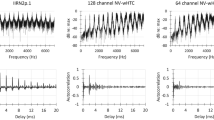Summary
Extracellular recordings were made from the midbrain auditory area to determine the limits of auditory frequency sensitivity in a variety of birds. The audiograms of some species show a consistent missing frequency range of 1/3 to 1/2 an octave, to which no neurons are tuned. All species, except owls, have a low upper frequency limit in comparison with mammals of similar headwidth. A consideration of both the upper frequency limits and the missing frequency ranges led to the conclusion that frequencies which do not generate localization cues are not represented in the midbrain. The upper frequency limit appears to match the upper limit of generation of significant interaural and monaural intensity cues to localization. The variation of these cues with frequency was examined through a simple model of the birds' sound receiving system which incorporated the interaural canal and considered the tympanic membranes as pressure difference receivers. Apart from coraciiform species, which have low upper frequency limits matching the frequency of the primary missing frequency band of other species, and owls, which have high upper frequency limits, the upper frequency limits of the birds studied are inversely related to head-width.
The argument for missing frequency ranges being related to nonlocalizable frequencies is simpler, for it has been found previously, using cochlear microphonic recording, that within a bird's audiogram there are frequency regions with poor directionality cues. These regions appear to correspond to the missing frequency ranges.
Similar content being viewed by others
Abbreviations
- nMLD :
-
nucleus mesencephalicus lateralis dorsalis
References
Aertsen AMHJ, Vlaming MSMG, Eggermont JJ, Johannesmsa PIM (1986) Directional hearing in the grassfrog (Rana temporaria L.). II. Acoustics and modelling of the auditory periphery. Hearing Res 21:17–40
Calford MB, Piddington RW (1988) Avian interaural canal enhances interaural delay. J Comp Physiol A 162:503–510
Calford MB, Wise LZ, Pettigrew JD (1985) Coding of sound location and frequency in the auditory midbrain of diurnal birds of prey, families Accipitridae and Falconidae. J Comp Physiol A 157:149–160
Chung SH, Pettigrew AG, Anson M (1981) Hearing in the frog: dynamics of the middle ear. Proc R Soc Lond B 212:459–485
Coles RB, Aitkin LM (1979) The response properties of auditory neurons in the midbrain of the domestic fowl (Gallus gallus) to monaural and binaural stimuli. J Comp Physiol 134:214–251
Coles RB, Lewis DB, Hill KG, Hutchings ME, Gower DM (1980) Directional hearing in the Japanese quail (Coturnix coturnix japonica). J Exp Biol 86:153–170
Dooling RJ (1980) Behavior and psychophysics of hearing in birds. In: Popper AN, Fay RR (eds) Comparative studies of hearing in vertebrates. Springer, Berlin Heidelberg New York, pp 261–288
Fletcher NH, Thwaites S (1979) Acoustical analysis of the auditory system of the cricketTeleogryllus commodus (Walker). J Acoust Soc Am 66:350–357
Heffner R, Heffner H (1980) Hearing in the elephant (Elephas maximus). Science 208:518–520
Hill KG, Lewis DB, Hutchings ME, Coles RB (1980) Directional hearing in the Japanese quail (Coturnix coturnix japonica). I. Acoustic properties of the auditory system. J Exp Biol 86:135–151
Irvine DRF (1987) Interaural intensity differences in the cat: changes in sound pressure level at the two ears associated with azimuthal displacements in the frontal horizontal plane. Hearing Res 26:267–286
Knudsen EI (1980) Sound localization in birds. In: Popper AN, Fay RR (eds) Comparative studies of hearing in vertebrates. Springer, Berlin Heidelberg New York, pp 289–321
Knudsen EI (1982) Auditory and visual maps of space in the optic tectum of the owl. J Neurosci 2:1177–1194
Knudsen EI, Konishi M (1978) Space and frequency are represented separately in the auditory midbrain of the owl. J Neurophysiol 41:870–884
Lewis B (1983) Directional cues for auditory localization. In: Lewis B (ed) Bioacoustics. Academic Press, London, pp 233–257
Masterton B, Heffner H, Ravizza R (1969) The evolution of human hearing. J Acoust Soc Am 45:966–985
Moiseff A, Konishi M (1981) The owl's interaural pathway is not involved in sound localization. J Comp Physiol 144:299–304
Morse PM (1948) Vibration and sound. McGraw-Hill, New York
Pinder AC, Palmer AR (1983) Mechanical properties of the frog ear: vibration measurements under free- and closedfield acoustic conditions. Proc R Soc Lond B 219:371–396
Rosowski JJ, Saunders JC (1980) Sound transmission through the avian interaural pathways. J Comp Physiol 136:183–190
Schwartzkopff J (1968) Structure and function of the ear and of the auditory brain areas in birds. In: DeReuck AVS, Knight J (eds) Hearing mechanisms in vertebrates. Churchill, London, pp 41–59
Smith CA (1981) Recent advances in structural correlates of auditory receptors. In: Ottoson D (ed) Progress in sensory physiology 2. Springer, Berlin Heidelberg New York, pp 135–187
Taylor MR (1978) Trapezoidal waveform generator. New Electronics 27:20–21
Wakeford O, Robinson DE (1974) Lateralization of tonal stimuli by the cat. J Acoust Soc Am 55:649–652
Woodworth RS (1962) Experimental psychology. Rinehart & Winston, New York
Young D, Hill KG (1977) Structure and function of the auditory system of the cicada,Cystosoma saundersii. J Comp Physiol 117:23–45
Author information
Authors and Affiliations
Rights and permissions
About this article
Cite this article
Calford, M.B. Constraints on the coding of sound frequency imposed by the avian interaural canal. J. Comp. Physiol. 162, 491–502 (1988). https://doi.org/10.1007/BF00612514
Accepted:
Issue Date:
DOI: https://doi.org/10.1007/BF00612514




